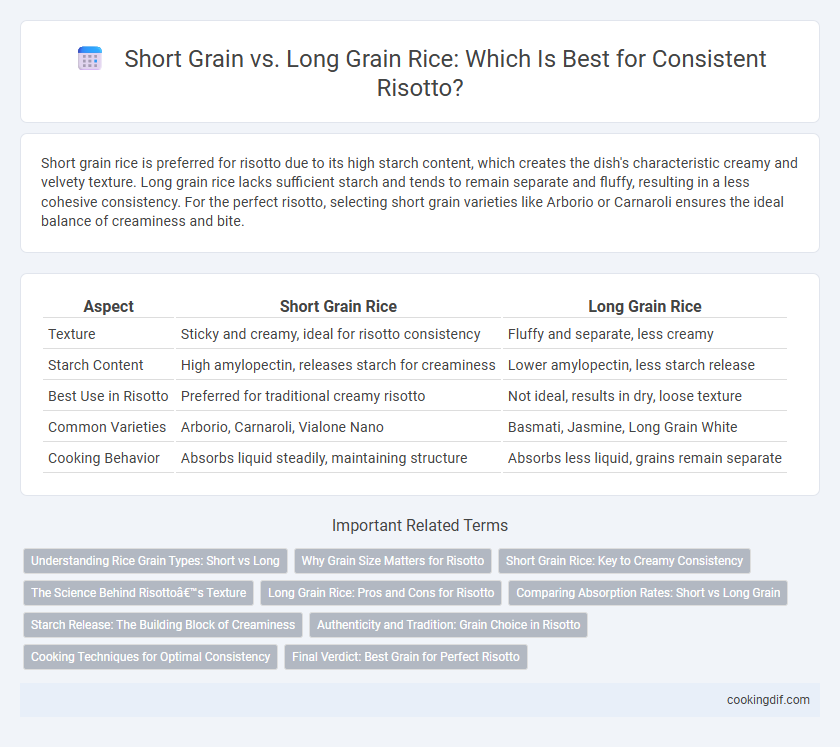Short grain rice is preferred for risotto due to its high starch content, which creates the dish's characteristic creamy and velvety texture. Long grain rice lacks sufficient starch and tends to remain separate and fluffy, resulting in a less cohesive consistency. For the perfect risotto, selecting short grain varieties like Arborio or Carnaroli ensures the ideal balance of creaminess and bite.
Table of Comparison
| Aspect | Short Grain Rice | Long Grain Rice |
|---|---|---|
| Texture | Sticky and creamy, ideal for risotto consistency | Fluffy and separate, less creamy |
| Starch Content | High amylopectin, releases starch for creaminess | Lower amylopectin, less starch release |
| Best Use in Risotto | Preferred for traditional creamy risotto | Not ideal, results in dry, loose texture |
| Common Varieties | Arborio, Carnaroli, Vialone Nano | Basmati, Jasmine, Long Grain White |
| Cooking Behavior | Absorbs liquid steadily, maintaining structure | Absorbs less liquid, grains remain separate |
Understanding Rice Grain Types: Short vs Long
Short grain rice varieties such as Arborio and Carnaroli have higher starch content, which releases more amylopectin during cooking, resulting in the creamy, cohesive texture essential for risotto. Long grain rice, like Basmati or Jasmine, contains less starch and remains separate and fluffy after cooking, making it unsuitable for achieving the traditional risotto consistency. Choosing the right rice grain type directly impacts the dish's texture and overall flavor profile, with short grain rice being the optimized choice for authentic risotto preparations.
Why Grain Size Matters for Risotto
Short grain rice, such as Arborio, is essential for risotto due to its high starch content and ability to absorb liquids without becoming mushy, creating the dish's signature creamy consistency. Long grain rice lacks the necessary starch and tends to remain separate and dry, preventing the characteristic creaminess of traditional risotto. Grain size and starch release directly impact the texture, making short grain rice the optimal choice for achieving risotto's rich and velvety finish.
Short Grain Rice: Key to Creamy Consistency
Short grain rice, particularly Arborio, plays a crucial role in achieving the creamy consistency characteristic of risotto due to its high starch content and ability to absorb liquids without becoming mushy. The rounder, plumper grains release amylopectin starch during slow cooking, creating the classic velvety texture that differentiates risotto from dishes made with long grain rice. In contrast, long grain rice retains firmness and separate grains, making it unsuitable for the rich, creamy mouthfeel essential to authentic risotto recipes.
The Science Behind Risotto’s Texture
Short grain rice, like Arborio or Carnaroli, is ideal for risotto due to its high amylopectin content, which releases starch and creates a creamy, cohesive texture. Long grain rice, with lower amylopectin and higher amylose, remains firmer and less sticky, resulting in a drier consistency unsuited for traditional risotto. The starch granules in short grain rice absorb liquids and swell during slow cooking, forming the signature velvety mouthfeel that defines authentic risotto.
Long Grain Rice: Pros and Cons for Risotto
Long grain rice has a distinct, firm texture that prevents it from becoming overly creamy, which is less ideal for traditional risotto recipes that rely on starch release for a creamy consistency. Unlike short grain varieties such as Arborio, which absorb liquid and release amylopectin for a rich, velvety texture, long grain rice tends to remain separate and fluffy. Choosing long grain rice for risotto can result in a less cohesive dish, but it offers the advantage of a lighter, less sticky finish that some prefer for alternative risotto styles.
Comparing Absorption Rates: Short vs Long Grain
Short grain rice, specifically Arborio, absorbs liquid more efficiently due to its high starch content, resulting in a creamy and consistent risotto texture. Long grain rice, such as Basmati or Jasmine, has a lower amylopectin level, leading to less absorption and a drier, fluffier consistency that lacks the characteristic risotto creaminess. This difference in absorption rates makes short grain rice the preferred choice for achieving the ideal balance of creaminess and firmness in risotto dishes.
Starch Release: The Building Block of Creaminess
Short grain rice varieties like Arborio release more starch during cooking, creating the creamy texture essential to traditional risotto. Long grain rice contains less amylopectin, resulting in fewer starch granules gelatinizing and thereby producing a firmer, less creamy consistency. The higher starch content in short grain rice is crucial for achieving the signature velvety mouthfeel that defines a perfect risotto.
Authenticity and Tradition: Grain Choice in Risotto
Short grain rice, particularly varieties like Arborio, Carnaroli, and Vialone Nano, is essential for authentic risotto due to its high amylopectin content, which ensures a creamy and consistent texture. Long grain rice lacks the necessary starch to achieve the traditional rich, velvety consistency characteristic of genuine Italian risotto. Choosing short grain rice preserves the dish's heritage and delivers the signature smoothness that defines classic risotto recipes.
Cooking Techniques for Optimal Consistency
Short grain rice, such as Arborio or Carnaroli, absorbs liquid more evenly and releases starch during cooking, creating the creamy texture essential for risotto. Long grain rice remains firmer and less sticky due to lower starch content, making it less suitable for achieving the desired risotto consistency. Proper stirring and gradual addition of broth during cooking enhance the starch release and ensure evenly cooked grains, maximizing the creamy, rich texture characteristic of authentic risotto.
Final Verdict: Best Grain for Perfect Risotto
Short grain rice, particularly Arborio, offers superior creaminess and starch release essential for the characteristic risotto texture, unlike long grain varieties which stay firmer and less creamy. The high amylopectin content in short grain rice ensures a rich, velvety consistency that long grain rice cannot match. For perfect risotto, short grain rice remains the best choice, combining optimal absorption and release of flavors.
Short grain vs Long grain for consistency Infographic

 cookingdif.com
cookingdif.com